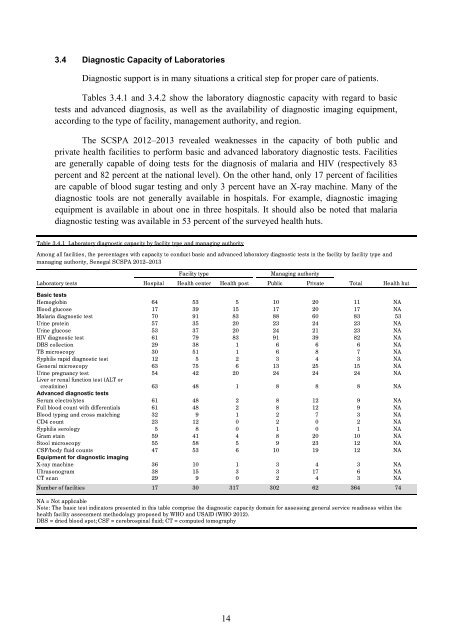CSwMR
CSwMR
CSwMR
Create successful ePaper yourself
Turn your PDF publications into a flip-book with our unique Google optimized e-Paper software.
3.4 Diagnostic Capacity of Laboratories<br />
Diagnostic support is in many situations a critical step for proper care of patients.<br />
Tables 3.4.1 and 3.4.2 show the laboratory diagnostic capacity with regard to basic<br />
tests and advanced diagnosis, as well as the availability of diagnostic imaging equipment,<br />
according to the type of facility, management authority, and region.<br />
The SCSPA 2012–2013 revealed weaknesses in the capacity of both public and<br />
private health facilities to perform basic and advanced laboratory diagnostic tests. Facilities<br />
are generally capable of doing tests for the diagnosis of malaria and HIV (respectively 83<br />
percent and 82 percent at the national level). On the other hand, only 17 percent of facilities<br />
are capable of blood sugar testing and only 3 percent have an X-ray machine. Many of the<br />
diagnostic tools are not generally available in hospitals. For example, diagnostic imaging<br />
equipment is available in about one in three hospitals. It should also be noted that malaria<br />
diagnostic testing was available in 53 percent of the surveyed health huts.<br />
Table 3.4.1 Laboratory diagnostic capacity by facility type and managing authority<br />
Among all facilities, the percentages with capacity to conduct basic and advanced laboratory diagnostic tests in the facility by facility type and<br />
managing authority, Senegal SCSPA 2012–2013<br />
Facility type<br />
Managing authority<br />
Laboratory tests<br />
Hospital Health center Health post Public Private<br />
Total<br />
Health hut<br />
Basic tests<br />
Hemoglobin 64 53 5 10 20 11 NA<br />
Blood glucose 17 39 15 17 20 17 NA<br />
Malaria diagnostic test 70 91 83 88 60 83 53<br />
Urine protein 57 35 20 23 24 23 NA<br />
Urine glucose 53 37 20 24 21 23 NA<br />
HIV diagnostic test 61 79 83 91 39 82 NA<br />
DBS collection 29 38 1 6 6 6 NA<br />
TB microscopy 30 51 1 6 8 7 NA<br />
Syphilis rapid diagnostic test 12 5 2 3 4 3 NA<br />
General microscopy 63 75 6 13 25 15 NA<br />
Urine pregnancy test 54 42 20 24 24 24 NA<br />
Liver or renal function test (ALT or<br />
creatinine) 63 48 1 8 8 8 NA<br />
Advanced diagnostic tests<br />
Serum electrolytes 61 48 2 8 12 9 NA<br />
Full blood count with differentials 61 48 2 8 12 9 NA<br />
Blood typing and cross matching 32 9 1 2 7 3 NA<br />
CD4 count 23 12 0 2 0 2 NA<br />
Syphilis serology 5 8 0 1 0 1 NA<br />
Gram stain 59 41 4 8 20 10 NA<br />
Stool microscopy 55 58 5 9 23 12 NA<br />
CSF/body fluid counts 47 53 6 10 19 12 NA<br />
Equipment for diagnostic imaging<br />
X-ray machine 36 10 1 3 4 3 NA<br />
Ultrasonogram 38 15 3 3 17 6 NA<br />
CT scan 29 9 0 2 4 3 NA<br />
Number of facilities 17 30 317 302 62 364 74<br />
NA = Not applicable<br />
Note: The basic test indicators presented in this table comprise the diagnostic capacity domain for assessing general service readiness within the<br />
health facility assessment methodology proposed by WHO and USAID (WHO 2012).<br />
DBS = dried blood spot; CSF = cerebrospinal fluid; CT = computed tomography<br />
14


